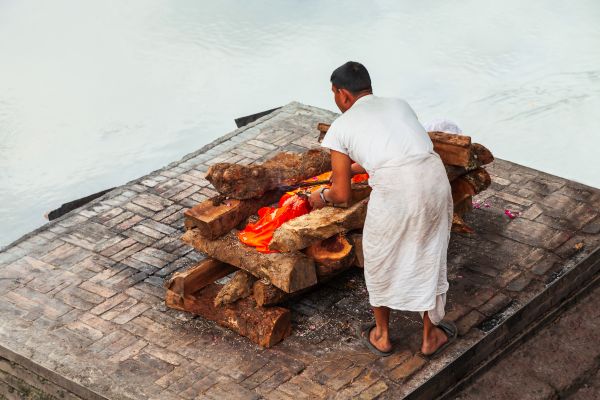Losing a child is one of the most heartbreaking experiences a family can face. In Hinduism, the death of a child is treated with deep compassion and spiritual understanding. Hindu beliefs teach that every soul is eternal and that death is not the end, but a step in the journey of the soul. However, when a young life ends early, the rituals and customs followed are often different from those for adults.
Hindu death rituals are meant to honor the departed soul and help it move peacefully to the next stage of existence. In the case of children, these rituals are usually simpler, based on the belief that young souls are pure and free from negative karma. The exact practices may vary depending on the child’s age, the family’s traditions, and regional customs.
Table of Contents
ToggleUnderstanding Death in Hinduism
In Hinduism, death is seen as a sacred and important moment. It marks the time when the soul leaves the body and moves to a new stage of its journey. Hindus believe in karma (the result of a person’s actions), dharma (a person’s duty), and moksha (freedom from the cycle of birth and death). The goal of every soul is to reach moksha, which means it will no longer be born again and will find peace.
To help the soul move on peacefully, Hindu families perform certain funeral rituals. These rituals are meant to guide the soul toward moksha. While the main purpose of the rituals is the same, different communities may have their own ways of performing them based on their customs and traditions.
Read More: What is Shraddha Ceremony? Importance and Rituals Explained
What Happens When a Family Loses a Child in the Hindu Religion?
Spiritual Significance of a Child’s Death:
In Hinduism, a child’s soul is considered innocent and untainted by worldly karma. Because of this, the death of a child is viewed through a lens of spiritual purity. The rituals are meant more for peace and remembrance than for cleansing karmic debts, which are more relevant in adult funerals.
Timely and Respectful Funeral Arrangements:
A funeral is arranged soon after the child’s death. Hindu customs emphasize a timely cremation or burial to allow the soul (Atman) to move forward in its spiritual journey without delays or attachments.
Ritual Preparation of the Body:
The child’s body is carefully bathed and dressed in clean, simple clothes—often white or soft-colored garments. The body is then laid respectfully on a white cloth or a wooden plank. A diya (oil lamp) is placed near the head, symbolizing the eternal light guiding the soul.
Family and Community Support:
Family members, relatives, friends, and neighbors gather to offer emotional and spiritual support. Their presence is not only to console the grieving parents but also to participate in the rituals that guide the soul on its onward path.
Dress Code and Atmosphere May Differ from Adult Funerals:
Traditionally, white is worn to represent mourning and purity. However, in a child’s funeral, the tone is often gentler. Some families may focus on celebrating the life of the child, leading to a softer emotional setting with less rigid dress codes.
Funeral Rituals Led by a Senior Male Member:
The lead rituals are typically performed by the father, grandfather, or an elder male in the family. These include offering flower garlands, applying sandalwood paste, lighting incense, and chanting Vedic mantras to bring peace to the soul and strength to the family.
Read More: Why Shanti Pooja is Important After Death?
Chanting of Sacred Mantras:
Peaceful mantras such as the “Om Namah Shivaya” or “Gayatri Mantra” are chanted to soothe the soul and calm the energy of the grieving space. These sacred sounds are believed to uplift the spirit and promote release from earthly ties.
Simplified Rituals Due to Child’s Purity:
Many traditional post-death rituals like pind daan, shraddha, or annual ceremonies are either not performed or are greatly simplified. This is based on the belief that the child’s soul is already close to moksha and doesn’t require elaborate karmic cleansing.
Sharing Loving Memories:
Family and friends may speak about the joy the child brought into their lives. These heartfelt tributes help turn the funeral into a celebration of life, offering healing to the grieving parents and community.
Spiritual and Emotional Closure:
The funeral ceremony acts as a sacred space for both spiritual transition and emotional release. It gives the family a chance to say goodbye in a meaningful way and begin the long journey of healing.
Honoring a Child’s Soul with Love, Faith, and Grace
The loss of a child is an unimaginable pain that words often fail to express. In Hinduism, the rituals performed after such a loss are not only acts of spiritual duty but also gestures of love, remembrance, and release. While the ceremonies may differ from those conducted for adults, they are deeply rooted in compassion, purity, and the belief that the soul of a child is already close to divine liberation. These sacred rites provide a path for the soul’s peaceful journey and offer comfort and closure to the grieving family and community. Through shared prayers, gentle rituals, and cherished memories, Hindu traditions help mourners honor the short yet meaningful life of the departed child with dignity and grace.
At Mokhprapti Funeral Services, we are committed to conducting sacred funeral rites with the highest respect and devotion. We provide customized funeral and cremation services to ensure that your loved one’s final rites are conducted with dignity and respect. Contact us today to discuss your needs and let us guide you through this challenging time with empathy and support.


